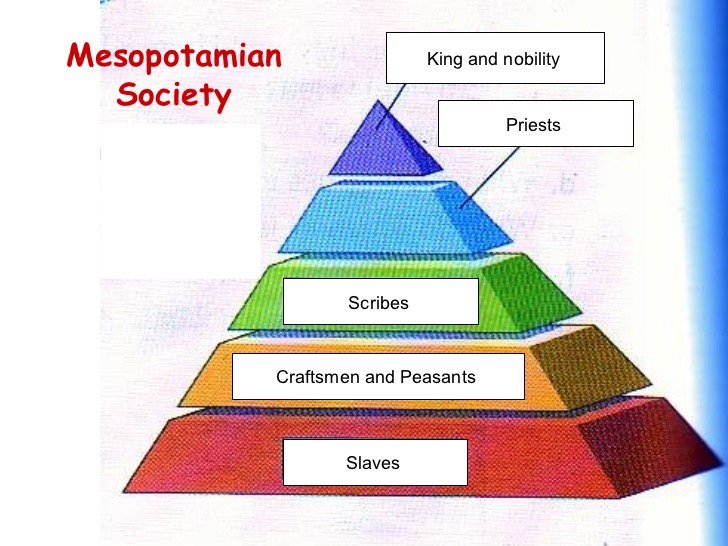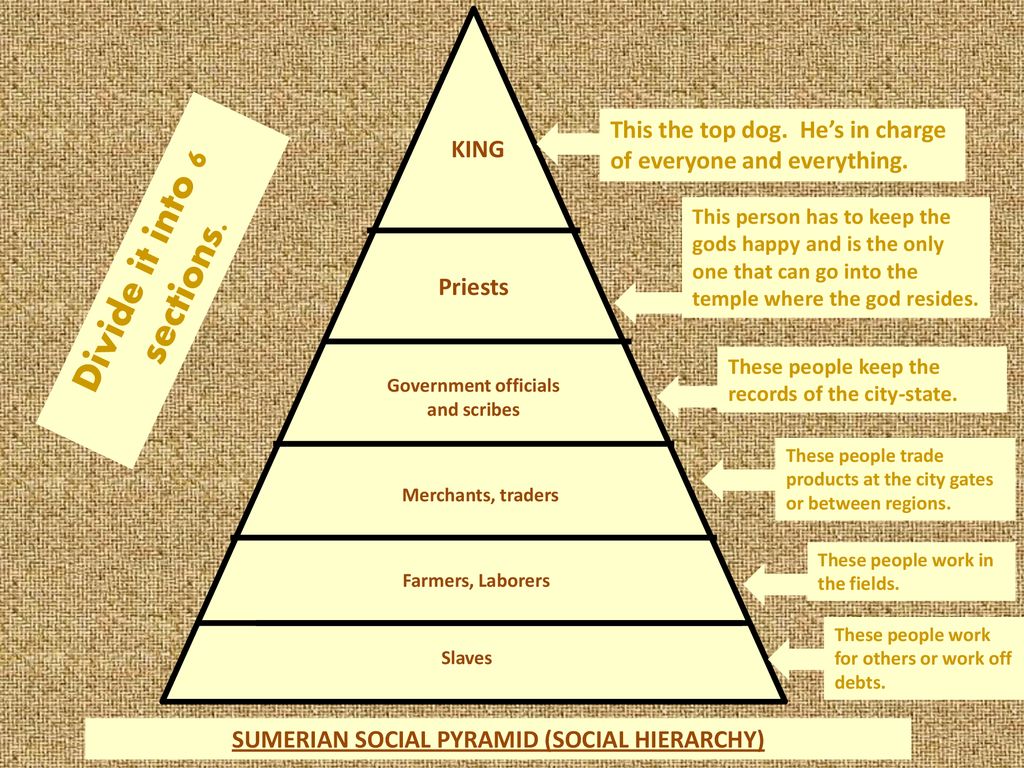Unveiling Mesopotamia's Social Pyramid: Roles & Classes
Did you know that the ancient Mesopotamians, despite living thousands of years ago, had a social structure that, in many ways, mirrors the complexities of our own modern societies? Their meticulously organized class system, a cornerstone of their civilization, dictated everything from daily life to legal rights, showcasing a level of societal organization that continues to fascinate historians and archaeologists today.
Mesopotamia, often hailed as the cradle of civilization, encompassed a region stretching from modern-day Iraq to parts of Syria, Turkey, and Iran. Flourishing between roughly 3500 BCE and 539 BCE, it witnessed the rise and fall of numerous empires, each leaving its unique imprint on the social landscape. The fertile lands between the Tigris and Euphrates rivers fostered agriculture, leading to the growth of cities and, consequently, the development of a complex social hierarchy. This hierarchy was not merely a static arrangement; it was a dynamic system, constantly evolving in response to environmental challenges, economic shifts, and political upheavals.
The very essence of Mesopotamian society was shaped by its social classes. These weren't just abstract labels; they were the defining features of a person's existence. From the moment of birth, an individual's social class determined their opportunities, their rights, and even the punishments they faced under the law. The system, a reflection of the era's economic realities and power dynamics, dictated everything from what clothing one wore to how one interacted with the gods.
- Hdhub4u Your Guide To Free Movie Downloads Streaming In 2024
- Remote Iot With Raspberry Pi Aws A Free Download Guide
| Aspect | Details |
|---|---|
| Social Structure Overview | The social structure in Mesopotamia was rigidly hierarchical, comprised of distinct classes. The major classes are: King, Royal family, Priests, Nobility, Upper Class (Scribes, Merchants), Lower Class (Farmers, Laborers, Craftsmen), and Slaves. |
| Class Stratification Basis | Primarily determined by occupation, wealth, and relationship to the gods and the ruling class. |
| Key Influences | Environmental factors (river flooding, need for irrigation), economic conditions (trade, agriculture), and political power structures. |
| Key Characteristics |
|
| Impact on Daily Life | Determined access to resources, types of work available, legal rights, and social interactions. |
| Governing Factors | Government in ancient Mesopotamia was based on the model of the family, where the father was the head of the household, and the concept of the gods as owners and rulers of the land. |
| Clothing and Appearance | Men wore long hair and beards, with skirt-like garments. Women wore long dresses, often with one shoulder bare. Jewelry was common for both. In colder months, cloaks made from wool were worn. |
| Role of Priests | Safeguards of the gods housed in temples. They held significant power in religious matters. |
| Link to source | Britannica - Mesopotamian Civilization |
At the apex of this social pyramid stood the king and the nobility. The king, considered a divine figure or chosen by the gods, wielded immense power. Their responsibilities were vast: governing the kingdom, making laws, leading religious ceremonies, and administering justice. The nobility, comprising the king's family, high-ranking officials, and wealthy landowners, assisted the king in these duties and enjoyed considerable privileges.
Closely intertwined with the ruling class were the priests, who occupied a position of paramount importance. They were the keepers of religious knowledge, interpreting the will of the gods and overseeing temple rituals. Temples were not just places of worship; they were also centers of economic activity, controlling vast landholdings and managing trade. Priests, therefore, held considerable influence and controlled the flow of resources within society. They were seen as intermediaries between the gods and the people, giving them unique power.
The upper class, the next tier of the social structure, consisted of scribes and merchants. Scribes, highly skilled individuals who could read and write, played a crucial role in administration, record-keeping, and the transmission of knowledge. They documented laws, managed financial transactions, and wrote religious texts. Merchants, on the other hand, facilitated trade, acquiring and selling goods both locally and internationally. They accumulated wealth through commerce and often enjoyed a comfortable standard of living.
- 607 Unc Net Worth In 2025 Music Wealth Secrets
- Unlock Remote Iot Magic Raspberry Pi Aws Vpc Free Learn Now
The lower class comprised the majority of the population: farmers, laborers, and craftsmen. Farmers toiled the land, cultivating crops and providing sustenance for the society. Laborers engaged in various manual tasks, such as construction and public works. Craftsmen, including artisans, metalworkers, and potters, produced a wide array of goods. Although they formed the backbone of the economy, they had limited social mobility and faced challenging working conditions.
At the very bottom of the hierarchy were the slaves. They were often prisoners of war, debtors, or individuals who had been forced into servitude. Slaves had no rights and were considered the property of their masters. They performed the most arduous tasks, such as working in mines, building structures, and serving in households. The number of slaves varied throughout Mesopotamian history, but their presence was a stark reminder of the social inequalities that characterized the era.
Social stratification in ancient Mesopotamia was, to a large extent, dictated by the environment. The fertile lands, while conducive to agriculture, were also prone to flooding. This necessitated the development of complex irrigation systems, which required organized labor and, in turn, contributed to the formation of social classes. The constant struggle against the elements reinforced the need for social coordination and hierarchical structures.
Furthermore, the class system was intrinsically linked to economic factors. The control of land, resources, and trade routes determined wealth and status. Those who controlled these aspects of the economy, such as the ruling class and the merchants, held significant power. The accumulation of wealth, often through trade and exploitation of labor, further solidified the existing social inequalities.
The influence of social class permeated every aspect of daily life. It determined one's access to resources, the type of work one performed, the legal rights one possessed, and even the kinds of clothing one wore. Royalty and nobility, for instance, enjoyed lavish lifestyles, elaborate garments, and access to the finest goods. In contrast, the lower classes lived a more austere existence, with limited access to resources and a constant struggle for survival.
The legal system in Mesopotamia also reflected the social hierarchy. The famous Code of Hammurabi, for example, included different punishments based on social class. A crime committed against a member of the upper class carried a harsher penalty than the same crime committed against a member of the lower class. This unequal treatment under the law further reinforced the existing social disparities.
The four levels of class include the nobles, the commoners, clients and slaves. In the upper class, there were the priests, landowners, and government officials. They lived in the middle, or center of the city.
The legacy of Mesopotamian social structure extends far beyond its historical context. Its hierarchical nature and the impact of occupation, wealth, and religion on societal roles serve as a compelling case study for understanding the evolution of social structures throughout history. From the king's palace to the slave's quarters, every element of Mesopotamian society offers insights into the human condition. Understanding these complex class divisions gives us an unparalleled look into the past and a deeper understanding of the roots of civilization.
The social hierarchy of ancient Mesopotamia highlights the stratification of society in ancient times. This system's impact on daily life, legal status, and economic opportunity demonstrates the complexities of early civilizations. The social structure provides an invaluable lens through which to examine the birth of social organization and societal structure.



Detail Author:
- Name : Douglas Gerlach
- Username : ustark
- Email : gusikowski.sigmund@gmail.com
- Birthdate : 2002-07-01
- Address : 2990 Augustine Bypass Retahaven, KY 93839-7166
- Phone : (269) 614-6249
- Company : Kunde Ltd
- Job : Automotive Specialty Technician
- Bio : Beatae magni doloribus architecto et itaque non quis. Voluptatem neque et quia atque. Suscipit et aut est quod occaecati at.
Socials
facebook:
- url : https://facebook.com/guyhayes
- username : guyhayes
- bio : Et consequatur tempora id sit magnam incidunt impedit quasi.
- followers : 3536
- following : 1940
tiktok:
- url : https://tiktok.com/@hayes1997
- username : hayes1997
- bio : Molestiae in minima sed saepe est. Ipsum id quam et qui dolores accusamus ut.
- followers : 4179
- following : 2377
instagram:
- url : https://instagram.com/hayes2009
- username : hayes2009
- bio : Rerum voluptatem tenetur iste a. Veniam odit aut molestiae soluta quo iusto.
- followers : 3977
- following : 1871
twitter:
- url : https://twitter.com/guy.hayes
- username : guy.hayes
- bio : Magni aut consequatur et aperiam et vitae. Totam provident sint rem eos ut odio. Quia magni neque at.
- followers : 1254
- following : 478